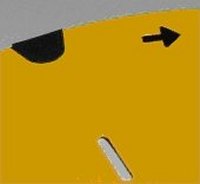|
CARTRIDGE & TONEARM ALIGNMENT
|
In the RINGMAT instructions it states:
"If there is height adjustment to the
tonearm, make such adjustments as are
necessary to ensure that the tonearm and
cartridge are aligned to the surface of
the record as is appropriate for the
design of the cartridge." Most
instructions for aligning the tonearm
and cartridge suggest that these should
lie parallel to the surface of the
record. Following the pioneering work of
Russ Andrews and others, further
research has shown that the 'parallel'
concept (virtually an industry standard)
is not usually the best approach for
most cartridges.
The aforementioned research has
confirmed that a far more accurate
signal, with much less distortion, can
usually be obtained by having the
tonearm sloping slightly down towards
the back (i.e. towards the pivot). It
was also found that when the stylus
pressure of the cartridge was set at a
point that was more suitable to the room
conditions (see following paragraph) the
pivot end of the tonearm needed to be
between 2mm and 2.5mm lower than the
headshell end. The reason for the range
of 0.5mm is that the optimum setting
varies from cartridge to cartridge (the
foregoing seems to be good for most
cartridges, typically with a nominal
tracking angle of 20° - 23° ) and also
from record to record, according to the
thickness of the vinyl and the angle at
which the record was cut; indeed, the
actual
|
|
|
|
Recommended further
reading...
|
|
|
|
|
variation to achieve an optimum stylus rake
angle for any record is around 1mm or more, but
the suggested range is typical of many records.
Where the tonearm is aligned as suggested above,
then in rooms of an average temperature and
humidity, stylus pressure should be set half way
between the mid-point and the bottom of the
recommended range for the cartridge - for very
warm rooms, stylus pressure should be lowered
towards the bottom of the range; for cooler
rooms, it should be increased towards the
mid-point. Further background information is
available from Ringmat Developments.
A suggested way to align the tonearm for an
ANNIVERSARY RINGMAT and other 330 models (which
raises the record about 3mm above the platter),
is to place a flat sheet of card or plastic with
a thickness of around 0.75mm* on the bare
platter and place a record on top. Then, by
measuring the distance between the surface of
the record and (1) the front and (2) the back of
the headshell (e.g. to the underside edge of the
headshell in each case), adjust the height of
the tonearm so that the distances, (1) and (2),
are the same. Then remove the sheet of card or
plastic and replace with the RINGMAT. Initially,
set stylus pressure according to room conditions
(see previous paragraph) and fine tune by
listening to one or two records in the normal
way - reducing pressure if the sound is heavy,
thick and slow, or increasing pressure if the
sound is rather thin with a hard edge, the bass
over-dynamic and lacking in extension, and the
sound generally too fast or 'mechanical
sounding', lacking emotion.
* A plastic shim of
0.75mm is available, if required, from Ringmat
Developments
|
 |
RINGMAT SPACERS and RINGMAT SUPPORT
SYSTEM
Now that RINGMAT Spacers are available,
either separately or as part of the
RINGMAT SUPPORT SYSTEM, this will not
only make many of the aforementioned
procedures much easier, but it will also
be possible to establish, quickly and
easily, an accurate setting for the LPs
in a collection. It should be
appreciated that, in a well optimised
system, an error of as little as 0.1mm
in the height of a record on the platter
will degrade reproduction considerably.
It is, in fact, the dominant parameter
affecting sound quality and that is why
so much emphasis has been placed on it
in these notes. RINGMAT Spacers also
provide an improved interface between
the low mass of a RINGMAT and the very
much higher mass of the platter,
generating a significant improvement in
the dynamics of music and other sounds
on playback, as well as enabling the
user to achieve a more accurate stylus
rake angle.
Ringmat Spacer - Mat Stud Engaged |
|